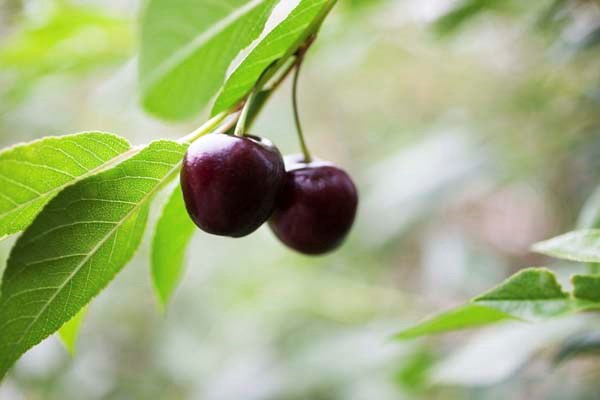Cherries on the Prairies! What a wonderful thing that is. All fun aside, the dwarf sour cherry is truly the best thing that has happened to the fruit industry but also is an amazing addition for every home gardener as the shrub is attractive, has blooms and, of course, produces that splendid fruit. I have a few cherries growing in my front yard and they do cause some excitement in my neighborhood.
In order to understand how this fabulous fruit was developed it is necessary to understand a little bit of fruit breeding history. Thousands of years ago, the sweet cherry (Prunus avium) was crossed with the Mongolian cherry (Prunus fruiticosa) which resulted in the sour cherry (Prunus cerasus). During the 20th Century, much breeding has occurred to increase the cold hardiness of the sour cherry which results in better survival in colder areas (like ours). For over 60 years there have been many, many people involved in the quest to develop a successful cherry for our region. For those involved with these breeding programs the fabulous dwarf sour cherry is often fondly referred to as the prairie cherry.
The dwarf sour cherry (Prunus cerasus) is truly a dwarf sour cherry and is not grafted but grows on its own rootstock. In 1999, ‘SK Carmine Jewel’ was released by the University of Saskatchewan as a named dwarf sour cherry cultivar. It is a very attractive shrub with glossy leaves and reaches a height of about two metres (6.5 feet). Each spring you will be rewarded with a showy bloom. The flowers are white and large and look spectacular against the glossy green foliage. The fruit when ripe has a dark purple skin and flesh and has a small pit in relation to the fruit size. It matures in late July or early August. The juice is a beautiful red colour, does not stain and can be used to make a multitude of products. This dwarf sour cherry is truly hardy here, is easy to grow and has very few problems with insects or disease.
Needless to say, this cherry has created much excitement, which in turn has created the impetus to develop different cultivars of these great prairie cherries. The benefit of growing different cultivars ensures a longer fruiting season for the grower, as some cherries will ripen earlier than others. As a general rule, cultivars that ripen earlier will be smaller and less sweet but the shrub itself will likely be slightly hardier. Those ripening later will generally have larger fruit and be slightly sweeter. In 2003, five experimental cultivars were released to the public by the University of Saskatchewan. They have also now been named and registered. The “Romance Series” of cherries are already proving to be popular. Do beware that it has been evident in my garden that they do sucker.
The “Romance Series”
‘Romeo’ is quite similar to SK Carmine Jewel both in the size of tree and the fruit itself. However, it does ripen later and usually will be ready to harvest in late August or early September.
‘Valentine’ is one of the most productive cultivars with fruit ripening in early to mid-August. The bush is slightly larger usually being about 2.5 m (8 feet) in height. The flavour of the cherries is a bit tarter than some of the other cultivars so is best suited for processing rather than fresh eating.
‘Crimson Passion’ is a slightly smaller bush reaching a height of 1.75m (5.5 feet). The fruit is dark red and is wonderful when eaten fresh. It matures mid-August. Of the series it is one of those with the highest sugar content.
‘Juliette’ is also excellent eaten fresh and ripens in early to mid-August. The bush will reach approximately 2 meters (6.5 feet).
‘Cupid’ has dark red to black fruit and is also very nice fresh. It matures late August to early September with a blooming time that is slightly later than most of the other cultivars.
All of these cultivars are self-fruitful. What that means is that they are able to produce fruit without another cherry as a pollinator. Fruit will set by self-pollination however; bees are needed to do the pollen transfer in the flower itself. Because of their dwarf stature, these cherries are suitable for every size of landscape and as you only need one to ensure fruit production it is a great option for smaller urban landscapes. However, after you have eaten and processed the fruit you will quickly wish that you had planted more than one to ensure you have more of that fabulous fruit. In my garden - this year was a bountiful crop!
Hanbidge is a horticulturist with the Saskatoon School of Horticulture and can be reached at 306-931-GROW(4769); by email at growyourfuture@gmail.com or check out our website at saskhort.com.
Enrol now for distance courses leading to a diploma or a certificate. Study with us or study in the comfort of your own home! Please contact us for further information or visit our website at saskhort.com.
Let our team of experts help you to create the outdoor living area of your dreams. Our team of educated and skilled experts can build or renovate your new or existing landscape. Including decks; gazebos; sunrooms; solariums; retaining walls; fences; irrigations systems; and regular maintenance.
Register now for Jr. Master Gardener Kids Camps this summer. The only camp left with space is August 17 to 21st. Check it out at www.saskhort.com.
Target Certificate in Horticulture Program – learn from the comfort of your home and gain the skills and education to work in the field of horticulture. Graduates from SSH are recognized by the industry as superb additions to help their horticultural business grow!
Like us on facebook at Saskatoon School of Horticulture and get in on all the events coming up and follow us on twitter @horticulturepat.



